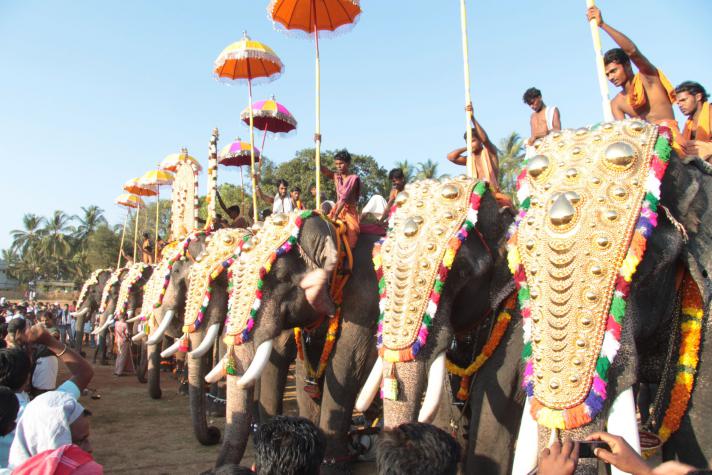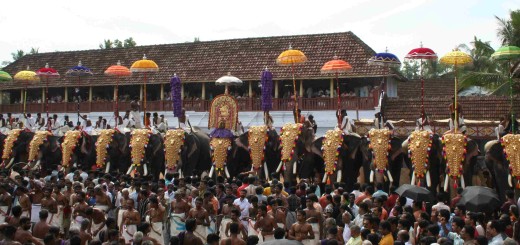Chinakkathoor Pooram
In Palakkad and Thrissur districts of Kerala, the festival season starts in February and continues until the end of April.
Chinakkathoor Pooram is a real feast for the eyes. Chinakkathoor Bhagavathi Temple, at Palappuram is only a few kilometers away from Ottappalam. The pooram is the annual festival of this temple. The major attraction, of course, is the elephant pageant. As many as 33 tuskers take part in the grand parade at Chinakkathoor Temple making this one of the most spectacular poorams in Kerala.

Chinakkathoor Pooram – 33 festooned animals take part in the Chinakkathoor Pooram at Ottappalam in Kerala.
The pooram involves performances of several different kinds. Panchavadyam is one of them. This is the traditional Kerala orchestra using five musical instruments. Four of these are percussion instruments, while one is a wind instrument.
In addition to the elephant pageant, Chinakkathoor Pooram has processions of bull effigies (Kalavela) and horse effigies (Kuthiravela). Ritualistic art forms like vellattu, poothanum thirayum and Theyyam are also performed. Tholpavakoothu which is a shadow puppet show is another attraction of the festival.
Chinakkathoor Pooram attracts tens of thousands of people from all over Kerala. Now that the tourism department of the Kerala government has started promoting this temple festival, it has started attracting people from other parts of the world as well. Festivities typically begin in the afternoon and go on until midnight and conclude with fireworks.
Chinakkathoor Pooram is a complete package. You will get to see processions involving elephants (real ones), bulls and horses (fake ones). You can enjoy the percussion orchestra (Panchavadyam), if that is your thing. You can watch several rural art forms like poothan and thira. Performed by male members of the Mannan community, these art forms are becoming extinct because there aren’t many performers. Now they are only performed during special occasions like poorams.
In 2016, the pooram was celebrated on February 22. In 2017, it will be celebrated on March 11.
How to reach?
Chinakkathoor Temple is only a few kilometers away from Ottappalam which is a major town in Palakkad district. From Ottappalam you can take a bus or an auto rickshaw. Board a bus to Palakkad and get off at Palappuram. The temple is only a few minutes’ walk from Palappuram.
The nearest railway station is Ottappalam railway station. The nearest airport is Coimbatore Airport.
What is a pooram?
If you want to watch a pooram you need to be in Palakkad or Thrissur district. There are temples all over Kerala and they all have their annual celebrations, but the pooram is a unique celebration. In the southern parts of Kerala, temple festivals are called utsavam or arattu. Both words mean festival, but a pooram is different from an utsavam or arattu in many ways. To start with, a pooram (also called a vela) involves greater participation of the public. Everyone irrespective of their caste or religion participates in a pooram or vela. This festival is held outside the temple premises so anyone can participate.
A pooram consists of numerous processions coming from all directions. They will start moving towards the main temple at around 2 pm. By 5 pm, most of these processions will have reached the temple where they will form a majestic lineup with other processions. A procession typically involves effigies of bulls or horses tied to bamboo poles. Young men will carry them on their shoulders and walk towards the temple. Each procession will be accompanied by their bands of orchestra and other performers. These processions typically start from a small temple that participates in the festival and people will join them as they move through the streets.

Decorated bulls at a pooram in North Kerala
When the procession reaches the temple, the bulls or horses are brought forward to salute the goddess. They will then retreat to the background. Each village wants their processions to be the best. Preparations typically start weeks in advance. There are unofficial bodies called pooram committees in every village. They collect donations and oversee the preparations. Funds are rarely an issue because people make generous contributions. The festival is held to propitiate the goddess who safeguards the residents of these villages from harm. In central and north Kerala, the pooram is much more than a festival. It involves the active participation of everyone in these villages. Actually, even those who have moved to other parts of the country, try to visit their native place during this time just to take part in the pooram.
The pooram also provides a great opportunity for people watching. On this day all roads certainly lead to the temple. You will find thousands of people in the streets and at the temple. Of course, you will find more men than women, but that is typical of festivals in Kerala. You may also want to read about Arattupuzha Pooram which is also celebrated in March.


